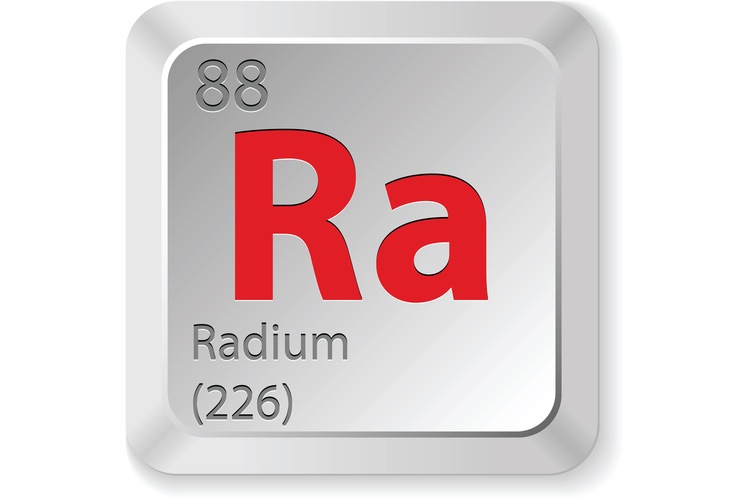Facts About Radium

Radium is a highly radioactive element and can be extremely dangerous. However, it was once used in many everyday products, including wristwatches and toothpaste, and thought to have curative properties until its intense radioactivity was found to cause adverse health effects.
Radium has an abundance of about 1 part per trillion in the Earth's crust, according to Chemicool. Trace amounts of radium are found in uranium ore, because radium is created from the decay of the uranium atom, which then into several other unstable elements before finally ending in the element lead. There are several known isotopes of radium, but due to the rapid decay rates of many of the isotopes, it is uncertain about the natural abundances of the radium isotopes.
Just the facts
- Atomic number (number of protons in the nucleus): 88
- Atomic symbol (on the periodic table of elements): Ra
- Atomic weight (average mass of the atom): 226
- Density: 3.2 ounces per cubic inch (5.5 grams per cubic cm)
- Phase at room temperature: solid
- Melting point: 1,292 degrees Fahrenheit (700 degrees Celsius)
- Boiling point: 2,084 F (1,140 C)
- Number of natural isotopes (atoms of the same element with a different number of neutrons): 33
- Most common isotopes: Ra-226 (unknown percent of natural abundance), Ra-223 (unknown percent of natural abundance), Ra-224 (unknown percent of natural abundance), Ra-228 (unknown percent of natural abundance)

History
Marie and Pierre Curie, Polish and French chemists, discovered radium in 1898, according to New World Encyclopedia. The discovery came from the study of pitchblende (a type of uranium ore) found in Bohemia (today's Czech Republic). The uranium was removed from the ore and the remains were found to still be radioactive. The radioactive remains were then separated out and when the spectrum was studied, the material was found to be primarily barium with an unknown element.
According to Peter van der Krogt, a Dutch historian, the element was named for the Latin word "radius" or "ray" because the radiation emitted from the new element was about 3 million times greater than the radiation from uranium. The Curies were able to extract about 1 milligram of radium from nearly 10 tons of pitchblende, according to the Royal Society of Chemistry.
Pure radium was isolated in 1902 by electrolysis by Marie Curie and Andre Debierne, a French chemist, according to New World Encyclopedia. Radium E, known to be bismuth-210, was the first synthetic radioactive element that was created synthetically by scientists at the University of California, according to Time.
Who knew?
- According to Chemicool, radium has an abundance in the Earth's crust about 1 part per trillion by weight. This makes it the 84thmost abundant element in Earth's crust according to Periodic Table.
- Radium is the heaviest alkaline earth metal, according to Encyclopedia. The other alkali earth metals include beryllium, magnesium, calcium, strontium and barium.
- Radium changes from a silvery white color to black when exposed to air, according to Lenntech due to oxidation.
- According to Chemicool, the radium isotope that has the longest half-life is radium-226 with a half-life of 1602 years.
- According to the Agency for Toxic Substances and Disease Registry, radium typically enters the body when it is breathed in or swallowed. Health effects from radium exposure include cancer, anemia, cataracts, and death.
- Radium emits alpha particles (two protons and two neutrons bonded together), beta particles (high energy electrons or positrons), and gamma rays (the most energetic wavelength of light), according to New World Encyclopedia.
- According to the Royal Society of Chemistry, radium is in the same group as calcium and is sometimes used to target bone cancer. Alpha particles emitted by the radium kills the cancerous cells.
- Radium is primarily extracted as a byproduct in uranium mining, according to the Royal Society of Chemistry. Most of the radium comes from uranium mines in Democratic Republic of Congo and Canada.
- According to Chemistry Explained, radium is extracted today from uranium ores in much the same way that Marie and Pierre Curie did in the late 1890s and early 1900s.
- According to Periodic Table, radium was used in clocks to paint the numbers and the hands so that they were visible in the dark. This practiced ceased after too many factory workers died from exposure.
- According to Encyclopedia, radium combines with nearly all non-metals including oxygen, fluorine, chlorine, and nitrogen.
- A curie (Ci) is a unit that is named for the amount of radiation emitted of a quantity of radionuclides that is equal to one gram of radium, or at a rate of decays at 37 billion disintegrations per second, according to the U.S. Nuclear Regulatory Commission.
- According to Lenntech, because radium is naturally occurring in small amounts in our environment, we are constantly exposed to small amounts of radiation. There is no evidence that the radium radiation levels are harmful.
- Marie and Pierre Curie's laboratory notebooks are still too radioactive due to their work with radium to be handled today, according to the Jefferson Lab.
- Due to her work with radium, Marie Curie was the first woman to win a Nobel Prize in physics (1903) and the first scientist to win two Nobel Prizes (second in 1911), according to Biography.
- According to the Los Alamos National Laboratory, radium is used to produce radon gas, which is typically used to treat several diseases including cancer.
- Radium is an unstable element and undergoes several stages of radioactive decay reaching its end product of lead, according to New World Encyclopedia.
Current research
Radium is often used to treat various forms of cancers. In a study published in the Journal of Nuclear Medicine, Isis Gayed and other researchers from Texas discuss treating bony metastases brought on by prostate cancer. The patients were treated with isotope Ra-223 and closely followed through treatments. Several factors were considered and compared before and after treatments including pain levels, PSA, creatinine, and hematological values. The patients that had lower PSA and creatinine levels and higher hemoglobin levels responded better to the radium treatments.
A 2014 article by Ashley Lehman, an American researcher, published in the Journal of Nuclear Medicine, discusses how the medication used in the above study, radium-223 dichloride (Xofigo), works. When radium encounters bone, it behaves similarly to calcium and gravitates toward where new bone formation is occurring. The radium in the medication collects in the bony metastatic sites there the damage from alpha particles being emitted by the decaying radium is primarily limited to the surrounding cancerous tissue as the alpha particles only travel short distances. The study concluded that using radium-223 was a promising treatment for those with prostate cancer and that the same treatment was currently being studied with in breast cancer patients who have developed bone metastases.
There are several ongoing trials for using radium-223 for breast cancer, including a double-blind, placebo-controlled trial by a group of American researchers, with an abstract published in the American Association for Cancer Research in 2015. The study is aiming to get a total of 227 participants to study the effects and safety of using radium to treat bony metastatic sites caused by breast cancer.
Additional resources
Sign up for the Live Science daily newsletter now
Get the world’s most fascinating discoveries delivered straight to your inbox.

Rachel Ross is a science writer and editor focusing on astronomy, Earth science, physical science and math. She holds a Bachelor of Arts in Philosophy from the University of California Davis and a Master's degree in astronomy from James Cook University. She also has a certificate in science writing from Stanford University. Prior to becoming a science writer, Rachel worked at the Las Cumbres Observatory in California, where she specialized in education and outreach, supplemented with science research and telescope operations. While studying for her undergraduate degree, Rachel also taught an introduction to astronomy lab and worked with a research astronomer.










